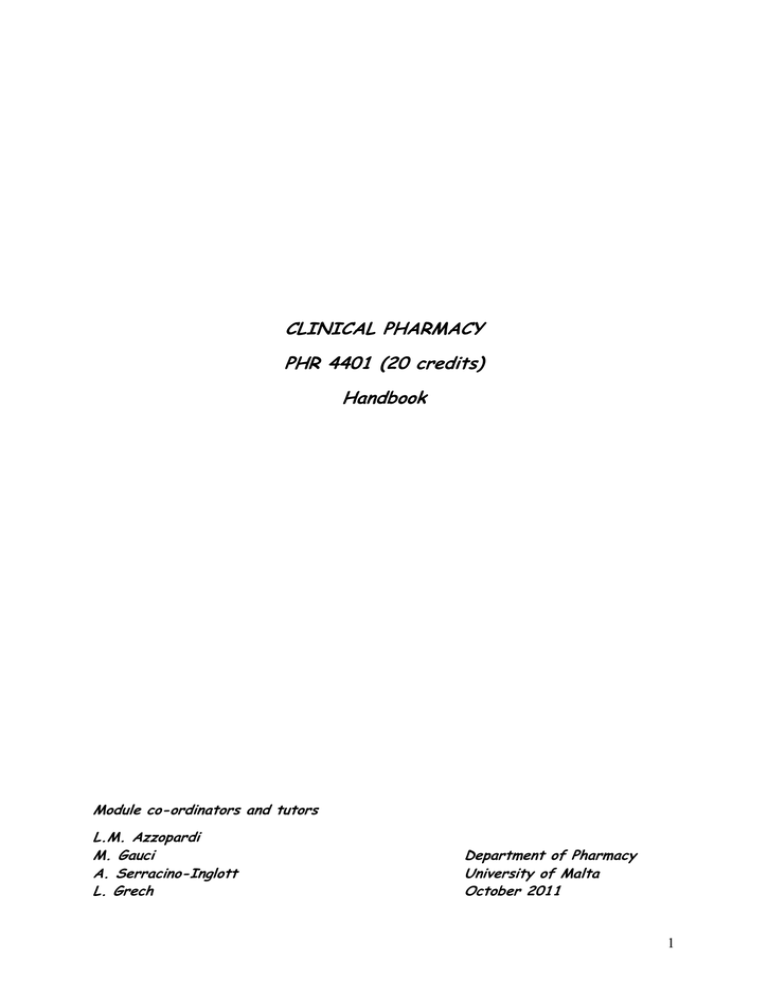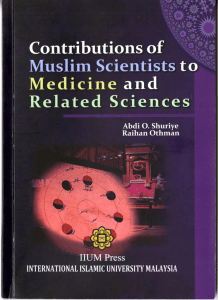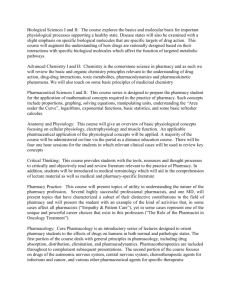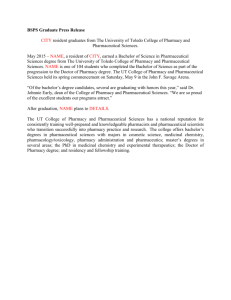CLINICAL PHARMACY PHR 4401 (20 credits) Handbook
advertisement

CLINICAL PHARMACY PHR 4401 (20 credits) Handbook Module co-ordinators and tutors L.M. Azzopardi M. Gauci A. Serracino-Inglott L. Grech Department of Pharmacy University of Malta October 2011 1 RATIONALE 1. Fourth year pharmacy students who opt to follow this area of specialisation will be assigned to a clinical attachment which will offer hands-on experience to the application of pharmacotherapeutics in the practical scenario. The aim of this module is that pharmacy students are presented with a continuous clinical experience in developing pharmaceutical care plans, monitoring outcomes, taking part in research and continuous practice development activities within a multidisciplinary team. 1.1 Learning Outcomes At the end of the placement, students should have experienced hands on practice on patient care process including multidisciplinary team involvement and developed the following skills: i. Application of pharmaceutical knowledge to real patient care ii. Ability to integrate clinical skills in the provision of pharmaceutical care iii. Identification of pharmaceutical care issues iv. Application of case management skills in collaboration with multidisciplinary team decisions v. Formulation, implementation and documentation of pharmaceutical care plans vi. Provision of patient counseling vii. Provision of drug information to other health care providers viii. Monitoring drug use and drug evaluation with reference to proper pharmacoeconomic applications ix. 2. Ethical and behavioural skills in patient care. STRUCTURE AND COURSEWORK This handbook is intended to present the basic framework for the clinical attachment period. A Record Sheet is provided for students to record their daily activities. Students should fill in the Record Sheet on a daily basis. 2 The Record Sheet should be completed daily and signed by the preceptor assigned for the supervision of the clinical attachment or the delegated person within the team. At the end of the clinical attachment, the Record Sheets should be submitted to the Department of Pharmacy as per deadline issued. Students are expected to attend the practice site for 30 hours per week. The schedule will be determined by the assigned preceptor. Any discrepancy in the hours of attendance should be discussed with the module co-ordinators. Any sick leave absence has to be reported to the Pharmacy Practice Lab at the Department of Pharmacy on contact number: 2340 2902 and the clinical attachment team should be informed. Students are expected to carry the British National Formulary for reference during the placement. 2.1 The Daily Record Sheet The record sheet has 3 main sections namely: i. Summary of activities The student is expected to record a brief summary of the daily proceedings covering the time spent within the clinical pharmacy attachment. ii. Interventions observed This section lists interventions which are commonly encountered within a clinical pharmacy placement. The student is expected to daily tick the relevant interventions observed. iii. Focus on intervention (s) observed This section allows the student to undertake a focused analysis of a choice of one or more interventions observed. The student is expected to be able to document and discuss and reflect upon the rationale behind the chosen interventions observed. Additional reference literature may be attached to this section for the student’s future reference only. 3 2.2 Tutorials Students will be allocated to groups and group tutorials will be held with the module co-ordinator and tutors. During these tutorials the students will have the opportunity to discuss any problems they are encountering within the attachment, present a case for discussion and also discuss the varying aspects and scenarios of clinical pharmacy practice. This is a learning experience and no mark will be allocated for the case discussions. 3. THE WORKPLACE 3.1 Dress code The attire should reflect the professionality of pharmacists and hence attire which is strictly not allowed includes halter or low cut tops and dresses, tops and dresses with straps or sleeveless tops, miniskirts, see through clothing, shorts, jeans, clothing with adverts or written statements, faded bleached or torn clothing. Shoes are to be clean and appropriately comfortable. No flip flops are allowed. Hair should be tied at the back. Make-up and perfumes can be worn as long they are subtle and not over done. Nail polish and artificial nails are not allowed. Jewellery worn must be discrete and subtle and only one pair of earrings are allowed. The preceptor and or the clinical team may ask students to go back home if they present to the placement not in line with the above dress code. 3.2 House keeping points A clean labcoat may be required to be worn. Students should wear the Department of Pharmacy Identification Tag at all times during the placement. For students attending their placement within Mater Dei Hospital they should wear Hospital Identification Badge at all times. 4 Hand Hygiene is essential especially after coming in contact with patients and on entering/leaving high risk areas such as theatres, ITU, NPICU, CCU, CICU, Cath lab. Valuable items such as car keys, money and mobile phones should be carried at all times by the student themselves unless a locker is provided. Mobile phones should be put on silent mode and calls should not be taken unless extremely important. 3.3 Data Protection Act Patient confidentiality is to be respected. Students within Mater Dei Hospital are asked to complete the Data Protection Act form and abide by the said form. 4. FAMILIARISATION WITH MEDICAL TEAMS AND WARDS A medical or surgical team follows a general hierarchy. The Consultant is the lead clinician and major decisions are taken by the Consultant. In general you will be assigned to the Consultant who will therefore be your guide and mentor during your attachment. The next senior of the team will be the Resident Specialist or Higher Specialist Trainee (HST). The Higher Specialist Trainee is undergoing specialisation programme within a chosen speciality. The Basic Specialist Trainee (BST) is the next senior down the list and is specialising in general areas. The House Officer is the most junior of the medical/surgical team. House Officers have to undergo 2 years pre-registration and are designated as FY1 or FY2 accordingly. The official ward round is Consultant-led and is therefore carried out by the Consultant on predetermined days. Other ward rounds may be carried out in the absence of the Consultant by the most senior of the doctors. House Officers are required to review in-patients on a daily basis. Students are to participate in the official as well as the daily ward rounds. 5 Multidisciplinary team work Physiotherapists, occupational therapists, speech language pathologists, specialist nurses and clinical pharmacists may also be present on the wards depending on the scenario. Each ward is headed by a Nursing Officer (NO) aided by a Deputy Nursing Officer. 5. THE PATIENT’S STAY 5.1 Admitting patients Every day there is a number of consultants on call according to general speciality. Within Mater Dei Hospital patients are admitted through Casualty (Accident and Emergency) and are randomly assigned under the care of a particular admitting Consultant. For surgical procedures, patients are usually admitted through an appointment system. (For other hospitals admittance follows a different protocol according to the hospital). The next day the admitted patients are seen during the official Post-Admission Ward Round led by the Consultant. During this consultation, the patient’s history is reviewed and a management plan is decided. In the next days, the patient is followed up until discharged. 5.2 Out-Patient Settings Follow up of patients occurs through out-patient clinics on preset appointment dates. Notes are documented in the patient’s file. For specialities running out-patient clinics, students are to participate in the outpatient clinics. 6 6. UNDERSTANDING CLINICAL CASE NOTES A standard pattern is generally followed for documenting clinical case notes which are legally binding. 1. History Patient data Presenting complaint (PC) History of presenting complaint (HOPC/HPC) Systemic enquiry (S/E) Past medical history (PMH) Family history (FH) Social history (SH) Drug history (DH) 2. On examination (O/E) General (information related to the patient’s general appearance and mental status e.g. jaundice, anaemia, cyanosis, clubbing, oedema, dehydration, confusion) Cardiovascular system (CVS) Respiratory system (RS) Gastrointestinal system (GIT) Nervous system (CNS) Genito-urinary system (GUT) Locomotor system (LS) The detail covered in each system is dependant on the relevance to the presenting complaint. 7 3. Differential diagnosis/impression The differential diagnosis or impression is listed in order of probability. In some cases the actual diagnosis may be noted. 4. Investigations Laboratory, radiological and any other investigations requested at the initial stage are noted. 5. Management Includes drug treatment, temperature charting, blood pressure monitoring, physiotherapy, special nursing care. Follow-up notes after the initial clerking usually consist of the date, jotting on the state and progress of the patient, results of investigations, notes of changes in drug or other therapy and further investigations requested. Sometimes reports of referrals (to other departments) will be noted among the follow-up notes. Results of laboratory investigations, X-Ray summaries etc. are usually filed at the back of the notes on a mount sheet. Referral letters are filed at the front of the notes while the discharge letter is usually at the back. The nursing report and the medication sheet are filed separately while the patient is in the ward and then placed in the patient’s file on discharge. 7. DRUG HISTORY TAKING Drug history taking by pharmacists involves interviewing the patient to obtain further information relating to drug therapy. 8 Preparing for the interview i. Prioritisation may be required (eg for polypharmacy, elderly, non-compliance issues, narrow therapeutic drugs). Choose the patients who will benefit most from an in-depth drug history. ii. If possible case notes need to be reviewed prior to patient interview. iii. Following self-introduction, the pharmacist should use open ended questions to lead the interview. Entitlement cards can be referred to if necessary. Check for drugs being currently taken, drugs which are OTC or herbal and allergies. iv. If the patient is uncommunicative or uncooperative the liason with the relatives/carer may be necessary. v. The confirmed drug history including any allergies should be discussed within the medical firm and documented accordingly. Important areas to consider in structuring the interview are: does the patient actually still take all the drugs prescribed? are the doses/frequencies correct? has the correct brand/formulation been documented? has anything been omitted? has the patient brought any medication and/or medication supply card to hospital, which can provide useful information? does the patient use any OTC medicines (e.g. laxatives, antidiarrhoeals, analgesics, antacids)? how compliant is the patient? how correct is the method of administration? does the patient have any problems, which he can relate to the medicines being taken (e.g. diarrhoea, constipation, blurred vision, dry mouth, headaches, heartburn, dizziness, sedation, insomnia)? 9 has the patient suffered from any adverse effects to medication taken in the past? Performing the interview Checklist Suitable location and time Introduction and purpose of interview Position for optimal communication Professional and caring attitude Assertiveness for maintaining control whilst allowing freedom Responsiveness to anxiety, lack of understanding, inappropriate attitudes Active listening Appropriate and consistent terminology Note-taking minimal and mentioned in introduction Conclusion on a positive note, thanking for co-operation. 8. DISCHARGE PLANNING/COUNSELING i. Patient education should be carried out as close as possible to the patient discharge once the discharge drug regimen is confirmed. ii. Prioritisation may be required since it may not always be possible to educate all patients. Patients who are on poly-pharmacy Patients who had treatment reviews resulting in considerable changes Patients with compliance issues Patients being prescribed medicinal products with a narrow therapeutic index Patients being prescribed particular dosage forms Patients undergoing stepping-up regimens Patients undergoing stepping-down or tailing-off regimens Patients being administered course treatments iii. During discharge counseling, patient confidentiality should be maintained where possible. 10 iv. Self introduction may be required unless patient is familiar with you. v. During ward rounds the clinical pharmacist might have already gathered enough information about each patient’s: knowledge about their respective health problems and medications physical and mental capability to use medications appropriately together with ability to understand information. vi. Carers or relatives should be involved when and as necessary. vii. Verbal instructions should be supplemented by written information. viii. Discharge counseling should include: Route of administration Dose required Timing of the day and frequency Potential adverse effects and how to deal with them Contra-indications Interactions (food/drug interactions) Other issues (family planning, breast-feeding, vaccines, surgical procedures) 9. Re-inforcement of medical advice CASE PRESENTATION A case presentation should be: i. concise ii. systematically ordered iii. relevant to the care of the patient iv. easily identifies the pharmaceutical care issues v. easily targets the pharmaceutical care issues. Case presentations are useful to: i. Disseminate information between pharmacists ii. Discuss pharmaceutical plans with other health care professionals including doctors and health authorities iii. As a teaching means 11 Case Presentation Format 1. Patient Identity Name: Initials used Age Sex Occupation 2. History of Presenting Complaint (HPC) Date of presentation to hospital or clinic Mode of admission, for example acute emergency or referral Presenting symptoms and time scale of their occurrence 3. Past medical History (PMH) Past medical problems listed, emphasising those relevant to the case and with attention to accurate sequence and timing of events including previous admissions to hospital and specialist referrals 4. Social History Smoking and alcohol habits Social circumstances including social and family support Unusual living conditions, travel or habits where these may be relevant to the patient’s medical condition Vaccines if relevant Drug allergies 5. Family History Relevant familial conditions Especially premature deaths of parents or siblings 6. Drug history(including herbal and OTC medication) Present drug treatment and its duration including decisions leading to present dosage Past drug treatment related to known past medical history 12 Past adverse reactions and known allergies The pharmacist’s own findings from inquiry with the patient 7. Examination details Relevant findings from the doctor’s systematic enquiry. As pharmacists we are mainly concerned with a brief summary of the main relevant findings which in turn effected clinical assessment and the therapeutic plan decisions. 8. Investigations Emphasis on abnormal findings and assessment of routine parameters of organ function. These may influence therapeutic decisions. 9. Impression or diagnosis () The diagnosis or list of possible diagnoses 10. Management plan The therapeutic plan in context with the medical management of the patient’s condition including multidisciplinary co-operation. Further investigations and seamless care 11. Clinical Progress Chronological account of progress relating key events and findings. Tables can be used for more effective dissemination of information. 12. Pharmaceutical care issues Discussion of the pharmaceutical care plan. 13



